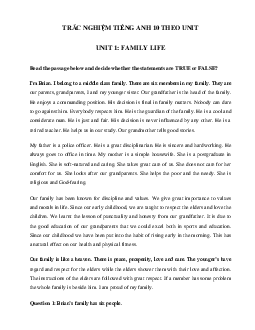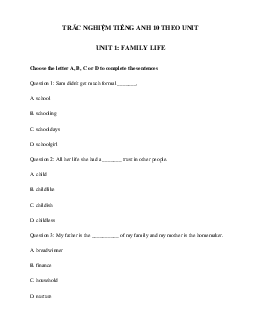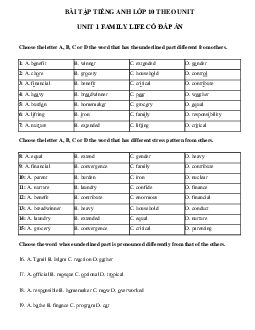





Preview text:
SGK TIẾNG ANH LỚP 10 i LEARN SMART WORLD
UNIT 1 FAMILY LIFE LESSON 3 Let's talk!
In pairs: How often do you send text messages and who do you send them to? What do
you write about? Theo cặp: Em thường gửi tin nhắn văn bản như thế nào và em gửi tin nhắn
cho ai? Em viết về cái gì? Gợi ý
I always use text messages. I often send them to my family members and my friends. I write
about my daily life and my important event.
Listening unit 1 lesson 3 Family life trang 10
a. Listen to someone talking about text messaging. The purpose of the talk is to… Nghe
một người nói về tin nhắn văn bản. Mục đích của buổi nói chuyện là để … Đáp án
b. give information about how its use
b. Now, listen and circle. Bây giờ, hãy nghe và khoanh vào đáp án đúng. Đáp án 1 - a 2 - a 3 - a 4 - b 5 - b Nội dung bài nghe
On December third, 1992, a software engineer called Neil Papworth sent the first text message
to his boss. It simply said "Merry Christmas." Now, millions of text messages are sent all over the world every day.
At first, SMS (Short Messaging Service) was not very popular. Cell phones were expensive, and
not everyone had an SMS service provider. But by the late 1990s and early 2000s, cell phones
were much cheaper. Today, people use text messaging in business and as a way to communicate
quickly with their family and friends. Texting even has its own language. It uses letters and
symbols instead of full words and sentences. LOL (laugh out loud) and ikr (I know, right?) are
in the Cambridge and Oxford dictionaries. Text messaging is very popular among young people.
In 2012, American teenagers sent an average of sixty texts a day. Many parents are not happy
with the amount of texting their children do. They think texting makes teenagers write badly
because they don't use capital letters or put periods at the ends of sentences.
Reading unit 1 lớp 10 lesson 3 trang 10
a. Read the text message. What does Adam want his father to do for him? Đọc tin nhắn văn
bản. Adam muốn bố làm gì cho mình? Adam: hey, Dad. How r u? Dad: What? Oh, I'm fine. Why?
Adam: can u pick me up from school 2nite @ 6:30?
Dad: Why are you going to be late? And don't forget you need to do your chores.
Adam: soccer practice np will do them 18r
Dad: OK. I'll be there at 6:30. Can you please write properly? I don't understand what you're trying to say. Adam: thx. c u l8r Đáp án 1 - to pick him up
b. Now, read and match the text language to its meaning. Bây giờ, hãy đọc và nối ngôn ngữ
nhắn tin với nghĩa của nó. Đáp án 2. 2nite - tonight 3. np - no problem 4. thx - thanks 5. c u - see you 6. @ - at
c. Now, read and answer the questions. Bây giờ, hãy đọc và trả lời các câu hỏi. Đáp án
1 - He is going to be at school at 6:30.
2 - Because he is going to practice soccer.
3 - His dad reminds him to do his chores.
4 - His dad asks him to write properly.
d. In pairs: Do you use any text language? Can your parents understand what you write?
Theo cặp: Em có sử dụng ngôn ngữ nhắn tin nào không? Bố mẹ của em có thể hiểu những gì em viết không? Gợi ý
I only use some popular text languages, so my parents can understand.
Writing lesson 3 unit 1 Family life lớp 10
a. Read about text language, then read Adam's text message again and underline all the
text language. Đọc về ngôn ngữ nhắn tin, sau đó đọc lại tin nhắn văn bản của Adam và gạch
chân tất cả ngôn ngữ nhắn tin. Đáp án Text language: How r u? u 2nite @ np 18r thx. c u l8r
b. Rewrite the text messages in full sentences with proper punctuation and spelling. Use
the skill box to help you. Viết lại tin nhắn văn bản thành câu đầy đủ với dấu câu và chính tả
thích hợp. Sử dụng bảng kỹ năng để giúp bạn. Đáp án 2 - See you later at the park 3 - You look sad. Are you ok? 4 - Got to go. Bye for now.
5 - I feel sad because my mother is angry. 6 - That was a great party!
Speaking unit 1 lớp 10 Family life lesson 3
a. In pairs: Talk about the last time you texted somebody to request something. What did
you ask for? How did you make the messages shorter with text language? Theo cặp: Nói về
lần cuối cùng bạn nhắn tin cho ai đó để yêu cầu điều gì đó. Bạn đã yêu cầu gì? Bạn đã làm cách
nào để làm cho các tin nhắn ngắn hơn bằng ngôn ngữ nhắn tin? Gợi ý
The last time I texted to my friend to ask about when and where we met.
I wrote "&" for "and" and "@" for at.
b. You need to ask your friend for help. Choose your role and plan your messages to make
and respond to a request. Think about the following questions. Em cần nhờ bạn bè giúp đỡ.
Chọn vai trò của em và sau đó lên kế hoạch tin nhắn để gửi và phản hồi yêu cầu. Hãy nghĩ về những câu hỏi sau. Who? (Ai?) Where? (Ở đâu?) What? (Cái gì?) When? (Khi nào?) Why? (Tại sao?)
>> Tham khảo chi tiết tại: You need to ask your friend for help. Choose your role and plan your
messages to make and respond... Đáp án gợi ý A: Hey Nga. How r u? B: Oh, I’m OK. Sup?
A: Can I borrow ur English student book?
B: Why? I think you have already had one.
A: I lost it & I need yours to use be4 my mother can buy it 4 me. B: OK! When will u pick it? A: At the skul g8. B: OK. A: thx. c u l8r.




